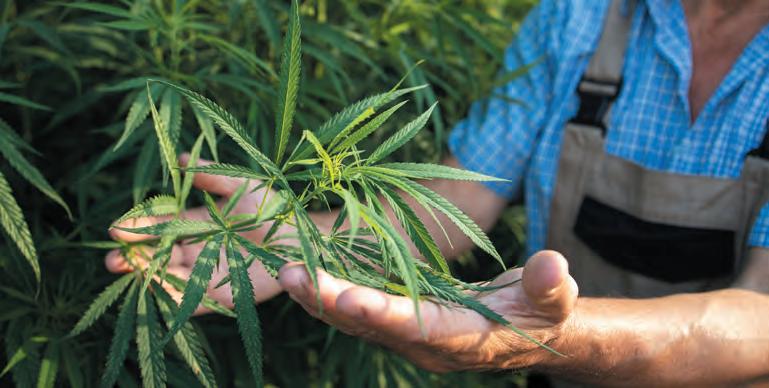
4 minute read
Flavor of the Month | Valentines Day Full
Adelaide, Cholame, Lake Nacimiento, Oak Shores, San Miguel, Shandon, Whitley Gardens, Baywood Park, California Men’s Colony, Cal Poly State University, Cambria, Cayucos, Cuesta-by-the-Sea, Cuesta College, Harmony, Los Osos, San Simeon, Avila Beach, Country Club, Edna-Los Ranchos, Edna Valley, Rolling Hills Estate, Shell Beach, Squire Canyon, Sunset Palisades, Black Lake Canyon, Callendar-Garrett, Cuyama, Halcyon, Huasna-Lopez, Los Berros, Nipomo, Nipomo Mesa, Oceano, Palo Mesa, California Valley, Creston, Garden Farms, Pozo, Santa Margarita.
The county has regulations for personal cultivation, dispensaries, commercial cultivation, nurseries, manufacturing, testing, and distribution facilities.
There are additional requirements for any permitted cannabis activity, such as cultivation, nurseries, distribution, and manufacturing, among a few others.
First is Separation from Sensitive Uses: “All permitted cannabis activities are required to be separated at least six-hundred (600) feet from any pre-school, elementary school, junior high school, high school, library, park, playground, recreation or youth center, licensed drug or alcohol recovery facility, or licensed sober living facility.
However, nurseries and cultivation are required to be separated by 1,000 feet but can request a modification.
When it comes to cannabis cultivation, water is a big concern for many. The county has a one-to-one water offset requirement for cannabis cultivation and nurseries in areas where the groundwater basin is at a severe level. Cannabis activities may not truck in water for their operations.
But the split vote between county supervisors is just an example of how split our county is on cannabis.
Drew Van Duren, a resident of Templeton, has been an active voice in the county against cannabis cultivation. He has previously spoken out against a potential cannabis farm near his home.
“My stance is laser-focused on the commercial growing and production of cannabis, and I’m very much against it being done in places where it can have a detrimental effect on the environment, resources, and the health and wellbeing of the population that shares that environment. Proposition 64 didn’t authorize this. Furthermore, 79 percent of the counties in California recognize the incompatibilities and simply don’t allow it,” said Van Duren.
Beth Parham, a resident of Paso Robles, works for a dispensary in San Luis Obispo. Parham only recently started working and showing interest in the cannabis industry. She and her husband use it about once a month.
Parham and her husband started to grow their cannabis plants out of curiosity and fun when it became legalized. When a position opened up at a dispensary in SLO, she thought, why not try it out. munities and their own constituents. There are over 2 million acres of unincorporated land in SLO County; a huge portion of that is zoned agricultural, some rural-residential. Most of those acres are in the strike zone of today’s SLO County cannabis ordinance, this despite the fact that the USDA does not categorize marijuana cannabis a ‘right to farm’ commodity to begin with.”
Parham feels people in our community who want to invest in cannabis cultivation are not trying to harm our community but instead bring in revenue and help rebuild our economy.
“I am absolutely in favor of commercial cannabis operations, including cannabis cultivation. Cannabis growers aren’t the stoners or criminals people imagine. They are farmers, just like all the produce farmers in the area, including the vineyards. Really, cannabis is just another crop that people are hesitant to allow in the community, just like grapes were years ago. The only difference is that cannabis, according to reports, uses less water. And since it is harvested as a whole plant and isn’t left to go dormant, poses less of a fire hazard. Tax revenue isn’t the only benefit cannabis can bring to a community. It brings jobs, income, and medicinal properties, including what some believe to be an alternative to pharmaceuticals.”
She explains, “The cannabis industry isn’t here to take over our communities. It isn’t here to bring crime or a decline in the quality of the community. It isn’t here to be a detriment. It is here to be a benefit. It is here to bring people a possible alternative to traditional pharmaceuticals. It is here to possibly bring a more profitable life to local farmers. It is here to bring more tax revenue to a community that was troubled by COVID and to provide more jobs for individuals like you and me. It isn’t the nightmare some people think it is. And, properly regulated and monitored, could be an incredibly advantageous addition to our community.”
For many who support the cannabis industry in SLO County, increased tax revenue is one of the first points they bring up.
Van Duren counters by saying cannabis is an unethical way to bring money into the county.
He says, “Whether or not cannabis makes money for the county is entirely beside the point. What matters most is how it makes that money. We should all question the ethical backbone of any county official or Supervisor who endorses a policy that pads cannabis industry and county coffers on the backs of comIf you or someone you know would like to share your insight into the subject, send an email to: camille@13starsmedia.com.









